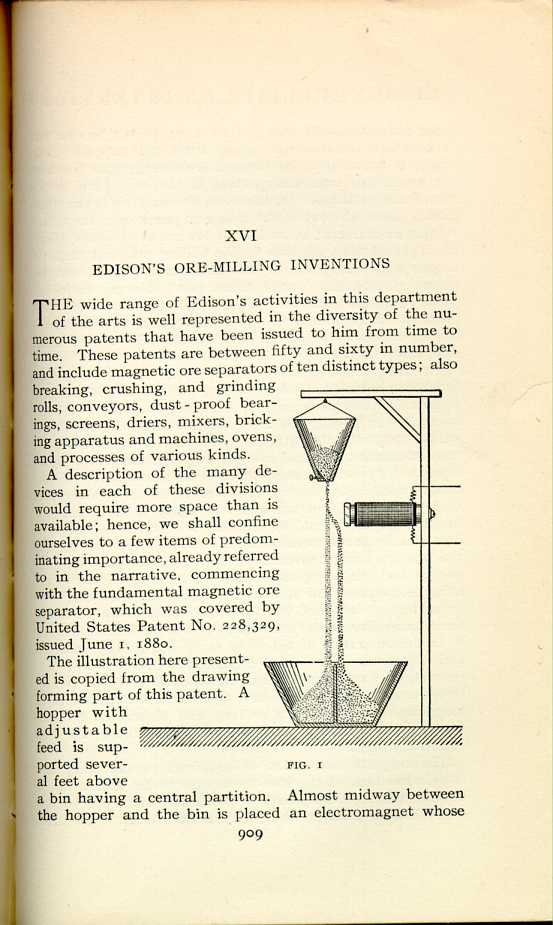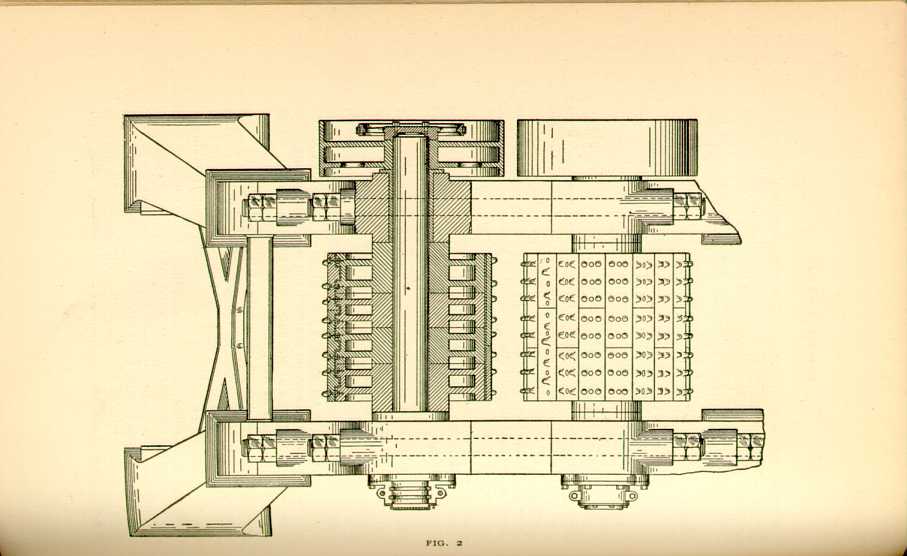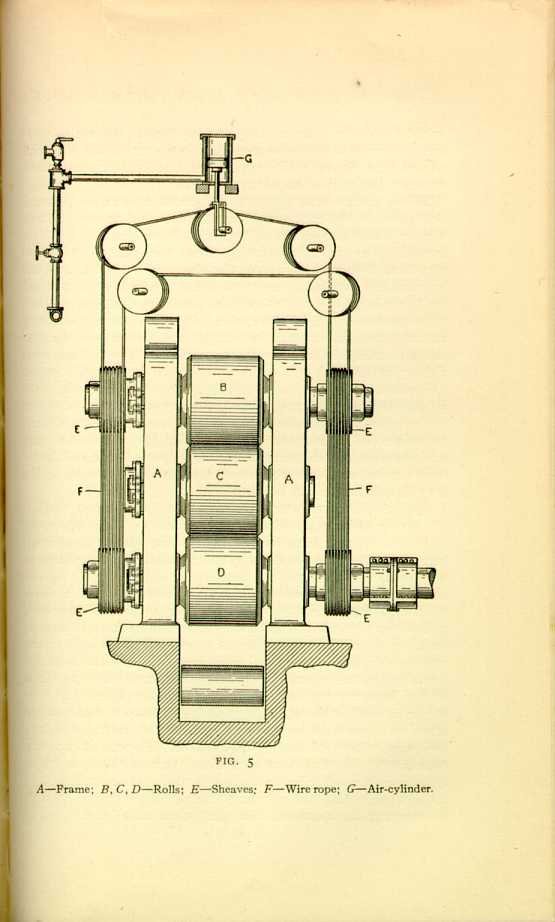|
XVI
EDISON'S ORE-MILLING INVENTIONS
Edison, His Life and Inventions, vol. 2 | ||
16.
XVI
EDISON'S ORE-MILLING INVENTIONS
THE wide range of Edison's activities in this department of the arts is well represented in the diversity of the numerous patents that have been issued to him from time to time. These patents are between fifty and sixty in number, and include magnetic ore separators of ten distinct types; also breaking, crushing, and grinding rolls, conveyors, dust-proof bearings, screens, driers, mixers, bricking apparatus and machines, ovens, and processes of various kinds.
A description of the many devices in each of these divisions would require more space than is available; hence, we shall confine ourselves to a few items of predominating importance, already referred to in the narrative. commencing with the fundamental magnetic ore separator, which was covered by United States Patent No. 228,329, issued June 1, 1880.
The illustration here presented
is copied from the drawing
forming part of this patent. A
hopper with
adjustable
feed is supported
several
feet above

FIG. 1
[Description: Drawing of the fundamental magnetic ore separator.]
This simple but effective principle was the one employed by Edison in his great concentrating plant already described. In practice, the numerous hoppers, magnets, and bins were many feet in length; and they were arranged in batteries of varied magnetic strength, in order that the intermingled mass of crushed rock and iron ore might be more thoroughly separated by being passed through magnetic fields of successively increasing degrees of attracting power. Altogether there were about four hundred and eighty of these immense magnets in the plant, distributed in various buildings in batteries as above mentioned, the crushed rock containing the iron ore being delivered to them by conveyors, and the gangue and ore being taken away after separation by two other conveyors and delivered elsewhere. The magnetic separators at first used by Edison at this plant were of the same generality as the ones employed some years previously in the separation of sea-shore sand, but greatly enlarged and improved. The varied experiences gained in the concentration of vast quantities of ore led naturally to a greater development, and several new types and arrangements of magnetic separators were evolved and elaborated by him from first to last, during the progress of the work at the concentrating plant.
The magnetic separation of iron from its ore being the foundation idea of the inventions now under discussion, a consideration of the separator has naturally taken precedence over those of collateral but inseparable interest. The ore-bearing
While this quotation refers to the method as "simple,'' the patent under consideration covers one of the most bold and daring projects that Edison has ever evolved. He proposed to eliminate the slow and expensive method of breaking large boulders manually, and to substitute therefor momentum and kinetic energy applied through the medium of massive machinery, which, in a few seconds, would break into small pieces a rock as big as an ordinary upright cottage piano, and weighing as much as six tons. Engineers to whom Edison communicated his ideas were unanimous in declaring the thing an impossibility; it was like driving two express-trains into each other at full speed to crack a great rock placed between them; that no practical machinery could be built to stand the terrific impact and strains. Edison's convictions were strong, however, and he persisted. The experiments were of heroic size, physically and financially, but after a struggle of several years and an expenditure of about $100,000, he realized the correctness and practicability of his plans in the success of the giant rolls, which were the outcome of his labors.
The giant rolls consist of a pair of iron cylinders of massive size and weight, with removable wearing plates having irregular surfaces formed by projecting knobs. These rolls are mounted side by side in a very heavy frame (leaving a gap of about fourteen inches between them), and are so belted up with the source of power that they run in opposite directions. The giant rolls described by Edison in the above-named patent as having been built and operated by him had a combined weight of 167,000 pounds, including all moving parts, which of themselves weighed about seventy tons, each

FIG. 2
[Description: Diagram of giant rolls used in the magnetic separators.]In Fig. 2 the rolls are illustrated diagrammatically. As a sketch of this nature, even if given with a definite scale, does not always carry an adequate idea of relative dimensions to a non-technical reader, we present in Fig. 3 a perspective illustration of the giant rolls as installed in the concentrating plant.
In practice, a small amount of power is applied to run the giant rolls gradually up to a surface speed of several thousand feet a minute. When this high speed is attained, masses of rock weighing several tons in one or more pieces are dumped into a hopper which guides them into the gap between the rapidly revolving rolls. The effect is to partially arrest the swift motion of the rolls instantaneously, and thereby develop and expend an enormous amount of kinetic energy, which with pile-driver effect cracks the rocks and breaks them into pieces small enough to pass through the fourteen-inch gap. As the power is applied to the rolls through slipping friction-clutches, the speed of the driving-pulleys is not materially reduced; hence the rolls may again be quickly speeded up to their highest velocity while another load of rock is being hoisted in position to be dumped into the hopper. It will be obvious from the foregoing that if it were attempted to supply the great energy necessary for this operation by direct application of steam-power, an engine of enormous horse-power would be required, and even then it is doubtful if one could be constructed of sufficient strength to withstand the terrific strains that would ensue. But the work is done by the great momentum and kinetic energy obtained by speeding up these tremendous masses of metal, and then suddenly opposing their progress, the engine being relieved of all strain through the medium of the slipping friction-clutches. Thus, this cyclopean operation may be continuously conducted with an amount of power prodigiously inferior, in proportion, to the results accomplished.
The sketch (Fig. 4) showing a large boulder being dumped into the hopper, or roll-pit, will serve to illustrate the method of feeding these great masses of rock to the rolls, and will

FIG. 3
[Description: Illustration of the dimensions of the magnetic separator.]After leaving the giant rolls the broken rock passed on through other crushing-rolls of somewhat similar construction.

FIG. 4
[Description: Sketch showing in boulder dumped into the hopper of the magnetic separator.]For the convenience of the reader, in referring to Fig. 5, we will repeat the description of the three-high rolls, which is given on pages 487 and 488 of the preceding narrative.
In the two end-pieces of a heavy iron frame were set three rolls, or cylinders—one in the centre, another below, and the other above—all three being in a vertical line. These rolls were about three feet in diameter, made of cast-iron, and had face-plates of chilled-iron. [16.2] The lowest roll was set in a fixed bearing at the bottom of the frame, and, therefore, could only turn around on its axis. The middle and top rolls were free to move up or down from and toward the lower roll, and the shafts of the middle and upper rolls were set in a loose bearing which could slip up and down in the iron frame. It will be apparent, therefore, that any material which passed in between the top and the middle rolls, and the middle and bottom rolls, could be ground as fine as

FIG. 5
A—Frame; B, C, D—Rolls; E—Sheaves; F—Wire
rope; G—Air-cylinder.
[Description: Diagram of Edison's grinding-machine, which uses "three-high"
rolls.]This pressure was applied in a most ingenious manner. On the ends of the shafts of the bottom and top rolls there were cylindrical sleeves, or bearings, having seven sheaves in which was run a half-inch endless wire rope. This rope was wound seven times over the sheaves as above, and led upward and over a single-groove sheave, which was operated by the piston of an air-cylinder, and in this manner the pressure was applied to the rolls. It will be seen, therefore that the system consisted in a single rope passed over sheaves and so arranged that it could be varied in length, thus providing for elasticity in exerting pressure and regulating it as desired. The efficiency of this system was incomparably greater than that of any other known crusher or grinder, for while a pressure of one hundred and twenty-five thousand pounds could be exerted by these rolls, friction was almost entirely eliminated, because the upper and lower roll bearings turned with the rolls and revolved in the wire rope, which constituted the bearing proper.
Several other important patents have been issued to Edison for crushing and grinding rolls, some of them being for elaborations and improvements of those above described but all covering methods of greater economy and effectiveness in rock-grinding.
Edison's work on conveyors during the period of his ore-concentrating labors was distinctively original, ingenious and far in advance of the times. His conception of the concentrating problem was broad and embraced an entire system, of which a principal item was the continuous transfer of enormous quantities of material from place to place at the lowest possible cost. As he contemplated the concentration of six thousand tons daily, the expense of manual labor to move such an immense quantity of rock, sand, and ore would be absolutely prohibitive. Hence, it became necessary to invent a system of conveyors that would be capable of transferring this mass of material from one place to another. And not only must these conveyors be capable of carrying the material, but they must also be devised so
Six of Edison's patents on conveyors include a variety of devices that have since came into broad general use for similar work, and have been the means of effecting great economies in numerous industries of widely varying kinds. Interesting as they are, however, we shall not attempt to describe them in detail, as the space required would be too great. They are specified in the list of patents following this Appendix, and may be examined in detail by any interested student.
In the same list will also be found a large number of Edison's patents on apparatus and methods of screening, drying, mixing, and briquetting, as well as for dust-proof bearings, and various types and groupings of separators, all of which were called forth by the exigencies and magnitude of his great undertaking, and without which he could not possibly have attained the successful physical results that crowned his labors. Edison's persistence in reducing the cost of his operations is noteworthy in connection with his screening and drying inventions, in which the utmost advantage is taken of the law of gravitation. With its assistance, which cost nothing, these operations were performed perfectly. It was only necessary to deliver the material at the top of the chambers, and during its natural descent it was screened or dried as the case might be.
All these inventions and devices, as well as those described
—Figs. 3 and 4 are reproduced from similar sketches on pages 84 and 85 of McClure's Magazine for November, 1897, by permission of S. S. McClure Co.
The faces of these rolls were smooth, but as three-high rolls came into use later in Edison's Portland cement operations the faces were corrugated so as to fit into each other, gear-fashion, to provide for a high rate of feed.
|
XVI
EDISON'S ORE-MILLING INVENTIONS
Edison, His Life and Inventions, vol. 2 | ||